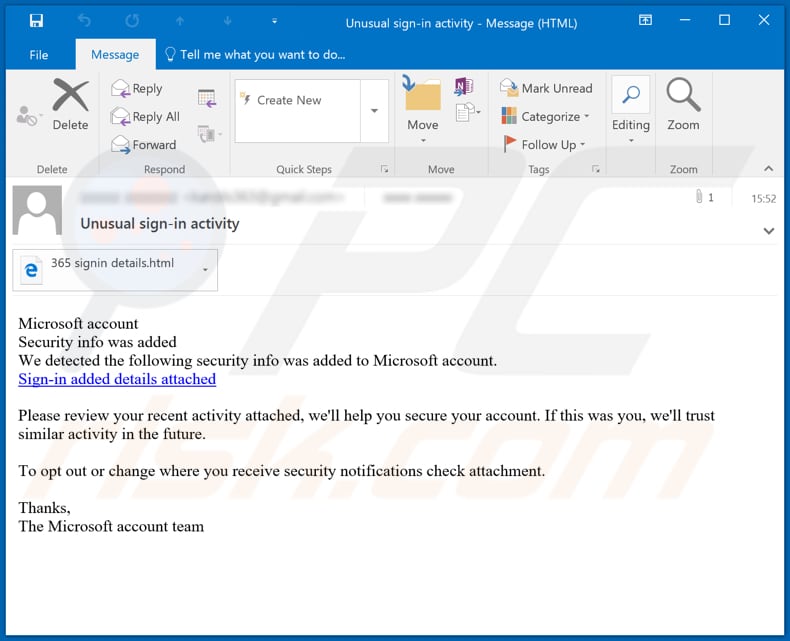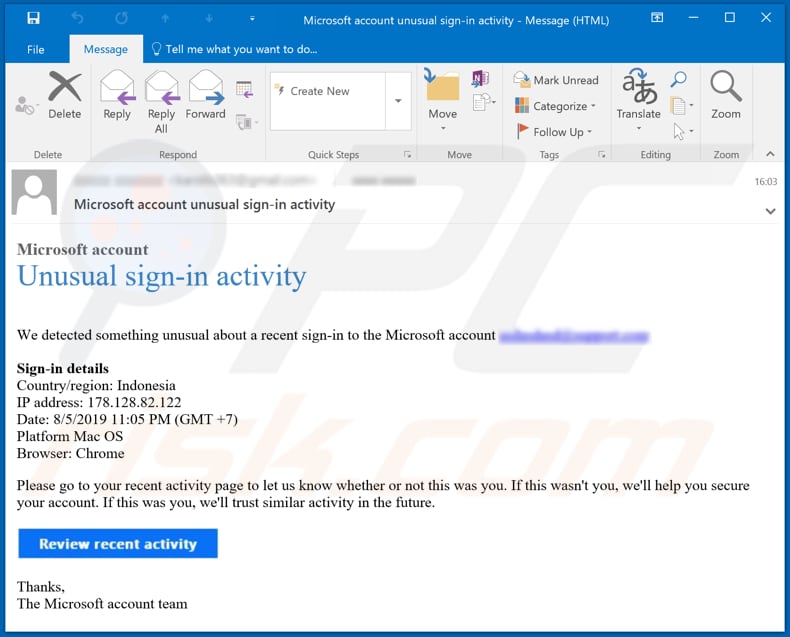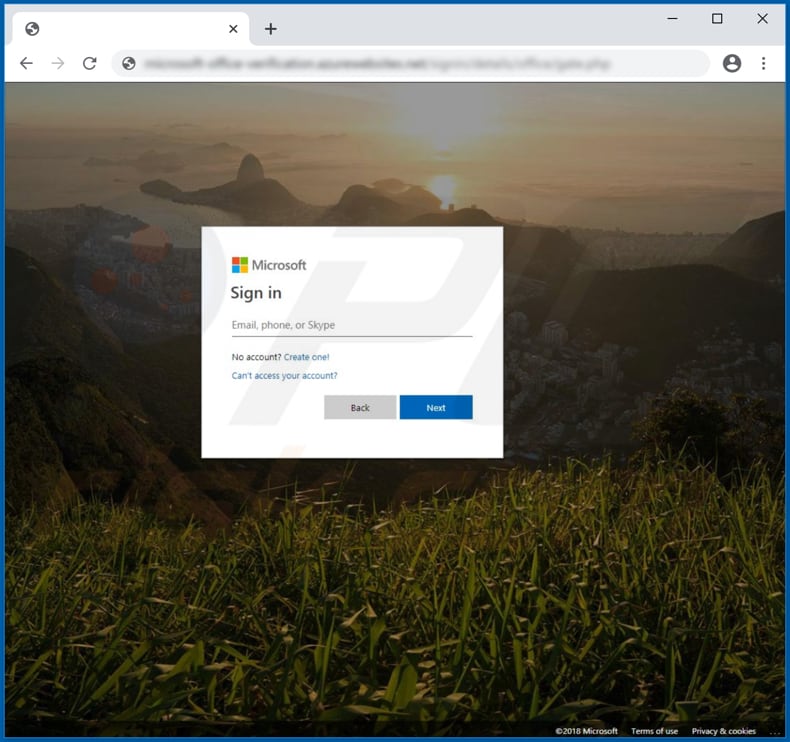Do not open links in emails disguised as messages from Microsoft
Phishing/ScamAlso Known As: Microsoft spam
Get free scan and check if your device is infected.
Remove it nowTo use full-featured product, you have to purchase a license for Combo Cleaner. Seven days free trial available. Combo Cleaner is owned and operated by RCS LT, the parent company of PCRisk.com.
What is "Microsoft Email Scam"?
Scammers attempt to deceive people into providing sensitive, personal information in various ways. In this particular case, they use a phishing campaign. I.e., they send emails disguised as messages from Microsoft regarding unusual sign-in activity.
Scammers spread this scam in order to trick unsuspecting people into entering credentials on a fake Microsoft account web page.

There are at least two variants of this email scam, which encourage recipients to secure their Microsoft accounts by signing into them through a provided link ("Sign-in added details attached" or "Review recent activity" button).
If clicked, this loads a fake Microsoft account sign-in page (some of these pages are hosted by azurewebsites[.]net) whereby users are asked to provide their credentials. If entered, this information is sent to scammers who then misuse the details to hijack Microsoft accounts or sell them to third parties.
Stolen accounts might also be used to make purchases, send spam to other people on contacts lists, share various files (including malicious ones), etc. Therefore, people might become victims of identity theft, suffer monetary loss, experience problems relating to online privacy, and so on.
Therefore, do not trust this scam and ignore similar emails. Commonly, Microsoft, Apple, Google and other companies notify customers/users when potentially unusual activity is discovered on their account. That is why some people might fall for this scam.
| Name | Microsoft Email Scam. |
| Threat Type | Phishing, Scam, Social Engineering, Fraud. |
| Fake Claim | Scammers claim that there was some unusual sign-in activity on the recipient's Microsoft account. |
| Disguise | This scam is disguised as a message from Microsoft. |
| Symptoms | Unauthorized online purchases, changed online account passwords, identity theft, illegal access of the computer. |
| Distribution methods | Deceptive emails, rogue online pop-up ads, search engine poisoning techniques, misspelled domains. |
| Damage | Loss of sensitive private information, monetary loss, identity theft. |
| Malware Removal (Windows) |
To eliminate possible malware infections, scan your computer with legitimate antivirus software. Our security researchers recommend using Combo Cleaner. Download Combo CleanerTo use full-featured product, you have to purchase a license for Combo Cleaner. 7 days free trial available. Combo Cleaner is owned and operated by RCS LT, the parent company of PCRisk.com. |
Spam campaigns are popular with scammers who attempt to trick recipients into providing sensitive information (credentials, credit card details), transferring money to them, etc. Some examples of other email scams include "COVID-19 Cases Surpassed 300,000 Email Scam", "Infect Your Family With CoronaVirus" and "Arabitol GLOBAL TRADING".
These emails can also be used to spread malware. In such cases, cyber criminals send emails that contain malicious attachments or website links designed to download the malicious files. They use spam campaigns to spread ransomware, Trojans, and other malware. For example, programs including Emotet, TrickBot, and LokiBot.
How do spam campaigns infect computers?
Computers become infected through emails only when recipients open (execute) a malicious an attached file, or open one that was downloaded through a link included in the email. In most cases, such emails contain a malicious Microsoft Office document, PDF document, executable file (.exe), JavaScript file or archive file such as ZIP, RAR.
Commonly, these emails are disguised as important, official messages from legitimate companies. Note that downloaded or attached malicious files cannot do any damage unless they are opened.
How to avoid installation of malware
All software and files should be downloaded from official websites and through direct links. Other channel such as third party downloaders and installers, Peer-to-Peer networks, freeware download pages, free file hosting sites, etc., should not be trusted. Cyber criminals often use them to distribute malware.
Operating systems and installed programs must be updated with implemented functions or tools provided by the official developers. Various unofficial activation ('cracking') tools can install malware. Furthermore, it is illegal to activate licensed programs with third party tools.
Attachments or links in irrelevant emails that were received from suspicious, unknown addresses should not be opened. Commonly, these emails are sent by cyber criminals who attempt to proliferate malware. They often disguise their emails as important, official, etc.
Finally, scan operating systems with reputable antivirus or anti-spyware software and keep it up to date. If you have already opened malicious attachments, we recommend running a scan with Combo Cleaner Antivirus for Windows to automatically eliminate infiltrated malware.
Text presented in the "Microsoft Email Scam" email message (see screenshot above):
Subject: Unusual sign-in activity
Microsoft account
Security info was added
We detected the following security info was added to Microsoft account.
Sign-in added attached
Please review your recent activity attached, we'll help you secure your account. If this was you, we'll trust similar activity in the future.
To opt out or change where you receive security notifications check attachment.
Thanks,
The Microsoft account team
Another variant of this scam:

Text in this scam:
Subject: Microsoft account unusual sign-in activity
Microsoft account
Unusual sign-in activityWe detected something unusual about a recent sign-in to the Microsoft account *******@support.com
Sign-in details
Country/region: Indonesia
IP address: 178.128.82.122
Date: 8/5/2019 11:05 PM (GMT +7)
Platform Mac OS
Browser: ChromePlease go to your recent activity page to let us know whether or not this was you. If this wasn't you, we'll help you secure your account. If this was you, we'll trust similar activity in the future.
Thanks,
The Microsoft account team
Fake Microsoft account sign-in page:

Instant automatic malware removal:
Manual threat removal might be a lengthy and complicated process that requires advanced IT skills. Combo Cleaner is a professional automatic malware removal tool that is recommended to get rid of malware. Download it by clicking the button below:
DOWNLOAD Combo CleanerBy downloading any software listed on this website you agree to our Privacy Policy and Terms of Use. To use full-featured product, you have to purchase a license for Combo Cleaner. 7 days free trial available. Combo Cleaner is owned and operated by RCS LT, the parent company of PCRisk.com.
Quick menu:
- What is Microsoft spam?
- Types of malicious emails.
- How to spot a malicious email?
- What to do if you fell for an email scam?
Types of malicious emails:
![]() Phishing Emails
Phishing Emails
Most commonly, cybercriminals use deceptive emails to trick Internet users into giving away their sensitive private information, for example, login information for various online services, email accounts, or online banking information.
Such attacks are called phishing. In a phishing attack, cybercriminals usually send an email message with some popular service logo (for example, Microsoft, DHL, Amazon, Netflix), create urgency (wrong shipping address, expired password, etc.), and place a link which they hope their potential victims will click on.
After clicking the link presented in such email message, victims are redirected to a fake website that looks identical or extremely similar to the original one. Victims are then asked to enter their password, credit card details, or some other information that gets stolen by cybercriminals.
![]() Emails with Malicious Attachments
Emails with Malicious Attachments
Another popular attack vector is email spam with malicious attachments that infect users' computers with malware. Malicious attachments usually carry trojans that are capable of stealing passwords, banking information, and other sensitive information.
In such attacks, cybercriminals' main goal is to trick their potential victims into opening an infected email attachment. To achieve this goal, email messages usually talk about recently received invoices, faxes, or voice messages.
If a potential victim falls for the lure and opens the attachment, their computers get infected, and cybercriminals can collect a lot of sensitive information.
While it's a more complicated method to steal personal information (spam filters and antivirus programs usually detect such attempts), if successful, cybercriminals can get a much wider array of data and can collect information for a long period of time.
![]() Sextortion Emails
Sextortion Emails
This is a type of phishing. In this case, users receive an email claiming that a cybercriminal could access the webcam of the potential victim and has a video recording of one's masturbation.
To get rid of the video, victims are asked to pay a ransom (usually using Bitcoin or another cryptocurrency). Nevertheless, all of these claims are false - users who receive such emails should ignore and delete them.
How to spot a malicious email?
While cyber criminals try to make their lure emails look trustworthy, here are some things that you should look for when trying to spot a phishing email:
- Check the sender's ("from") email address: Hover your mouse over the "from" address and check if it's legitimate. For example, if you received an email from Microsoft, be sure to check if the email address is @microsoft.com and not something suspicious like @m1crosoft.com, @microsfot.com, @account-security-noreply.com, etc.
- Check for generic greetings: If the greeting in the email is "Dear user", "Dear @youremail.com", "Dear valued customer", this should raise suspiciousness. Most commonly, companies call you by your name. Lack of this information could signal a phishing attempt.
- Check the links in the email: Hover your mouse over the link presented in the email, if the link that appears seems suspicious, don't click it. For example, if you received an email from Microsoft and the link in the email shows that it will go to firebasestorage.googleapis.com/v0... you shouldn't trust it. It's best not to click any links in the emails but to visit the company website that sent you the email in the first place.
- Don't blindly trust email attachments: Most commonly, legitimate companies will ask you to log in to their website and to view any documents there; if you received an email with an attachment, it's a good idea to scan it with an antivirus application. Infected email attachments are a common attack vector used by cybercriminals.
To minimise the risk of opening phishing and malicious emails we recommend using Combo Cleaner Antivirus for Windows.
Example of a spam email:

What to do if you fell for an email scam?
- If you clicked on a link in a phishing email and entered your password - be sure to change your password as soon as possible. Usually, cybercriminals collect stolen credentials and then sell them to other groups that use them for malicious purposes. If you change your password in a timely manner, there's a chance that criminals won't have enough time to do any damage.
- If you entered your credit card information - contact your bank as soon as possible and explain the situation. There's a good chance that you will need to cancel your compromised credit card and get a new one.
- If you see any signs of identity theft - you should immediately contact the Federal Trade Commission. This institution will collect information about your situation and create a personal recovery plan.
- If you opened a malicious attachment - your computer is probably infected, you should scan it with a reputable antivirus application. For this purpose, we recommend using Combo Cleaner Antivirus for Windows.
- Help other Internet users - report phishing emails to Anti-Phishing Working Group, FBI’s Internet Crime Complaint Center, National Fraud Information Center and U.S. Department of Justice.
Share:

Tomas Meskauskas
Expert security researcher, professional malware analyst
I am passionate about computer security and technology. I have an experience of over 10 years working in various companies related to computer technical issue solving and Internet security. I have been working as an author and editor for pcrisk.com since 2010. Follow me on Twitter and LinkedIn to stay informed about the latest online security threats.
PCrisk security portal is brought by a company RCS LT.
Joined forces of security researchers help educate computer users about the latest online security threats. More information about the company RCS LT.
Our malware removal guides are free. However, if you want to support us you can send us a donation.
DonatePCrisk security portal is brought by a company RCS LT.
Joined forces of security researchers help educate computer users about the latest online security threats. More information about the company RCS LT.
Our malware removal guides are free. However, if you want to support us you can send us a donation.
Donate
▼ Show Discussion